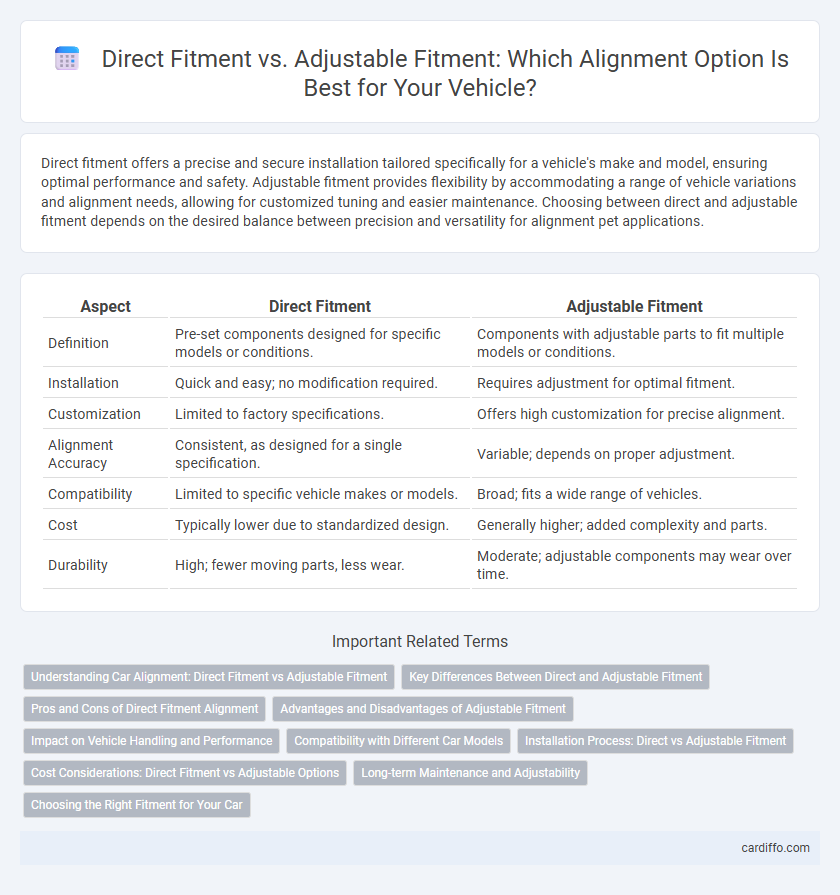Direct fitment offers a precise and secure installation tailored specifically for a vehicle's make and model, ensuring optimal performance and safety. Adjustable fitment provides flexibility by accommodating a range of vehicle variations and alignment needs, allowing for customized tuning and easier maintenance. Choosing between direct and adjustable fitment depends on the desired balance between precision and versatility for alignment pet applications.
Table of Comparison
| Aspect | Direct Fitment | Adjustable Fitment |
|---|---|---|
| Definition | Pre-set components designed for specific models or conditions. | Components with adjustable parts to fit multiple models or conditions. |
| Installation | Quick and easy; no modification required. | Requires adjustment for optimal fitment. |
| Customization | Limited to factory specifications. | Offers high customization for precise alignment. |
| Alignment Accuracy | Consistent, as designed for a single specification. | Variable; depends on proper adjustment. |
| Compatibility | Limited to specific vehicle makes or models. | Broad; fits a wide range of vehicles. |
| Cost | Typically lower due to standardized design. | Generally higher; added complexity and parts. |
| Durability | High; fewer moving parts, less wear. | Moderate; adjustable components may wear over time. |
Understanding Car Alignment: Direct Fitment vs Adjustable Fitment
Direct fitment in car alignment refers to pre-set suspension components designed to match specific vehicle specifications, ensuring precise factory-aligned geometry without further modifications. Adjustable fitment involves components such as adjustable control arms or camber kits that allow fine-tuning of alignment angles like camber, caster, and toe for customized handling or compensating for wear. Understanding the differences between direct and adjustable fitment helps optimize vehicle performance, tire wear, and driving safety based on specific alignment needs.
Key Differences Between Direct and Adjustable Fitment
Direct fitment offers a precise, manufacturer-specified alignment solution that ensures exact compatibility and minimal installation time, ideal for vehicles requiring factory-standard specifications. Adjustable fitment allows for customized alignment settings, providing flexibility to optimize handling and performance across various driving conditions or suspension modifications. Key differences include the ease of installation and range of alignment adjustments, with direct fitment focusing on exact replacement and adjustable fitment enabling tailored tuning.
Pros and Cons of Direct Fitment Alignment
Direct fitment alignment offers precise, factory-specified positioning that ensures consistent handling and tire wear, reducing the risk of suspension damage due to incorrect adjustments. However, its limitation lies in the lack of flexibility for fine-tuning alignment angles to accommodate specific driving styles or aftermarket modifications. This fixed setup may not optimize performance for vehicles requiring custom alignment settings, making adjustable fitment a preferable choice for enthusiasts seeking tailored handling characteristics.
Advantages and Disadvantages of Adjustable Fitment
Adjustable fitment offers enhanced customization for precise wheel alignment, accommodating various vehicle specifications and driving conditions to improve handling and tire longevity. Its flexibility allows for correction of alignment issues caused by wear or modifications, but improper adjustments can lead to uneven tire wear or compromised vehicle stability. While adjustable fitment provides greater control over alignment parameters, it requires expert installation and regular maintenance to ensure optimal performance and safety.
Impact on Vehicle Handling and Performance
Direct fitment provides precise wheel alignment tailored to the vehicle's factory specifications, ensuring optimal handling and consistent performance under standard driving conditions. Adjustable fitment allows for customized alignment settings, enabling enhanced cornering, improved traction, and better adaptability to specific driving styles or road conditions. Proper selection between direct and adjustable fitment significantly influences vehicle stability, tire wear, and overall driving dynamics.
Compatibility with Different Car Models
Direct fitment offers precise alignment components tailored to specific car models, ensuring optimal compatibility and ease of installation. Adjustable fitment provides versatile alignment options adaptable to a wider range of vehicles, accommodating varying suspension geometries and custom setups. Choosing between direct and adjustable fitment depends on the vehicle's make, model, and the desired level of alignment customization.
Installation Process: Direct vs Adjustable Fitment
Direct fitment offers a streamlined installation process with pre-engineered components that match vehicle specifications, minimizing the need for adjustments and reducing labor time. Adjustable fitment requires precise calibration during installation to tailor alignment settings, offering greater flexibility but increasing complexity and installation duration. Efficient alignment outcomes depend on choosing the appropriate fitment type to balance accuracy with installation efficiency.
Cost Considerations: Direct Fitment vs Adjustable Options
Direct fitment components typically offer a lower upfront cost due to standardized designs and mass production, making them an economical choice for basic alignment needs. Adjustable fitment options incur higher initial expenses but provide enhanced precision and flexibility, potentially reducing long-term maintenance costs by allowing fine-tuned alignment adjustments. Evaluating cost considerations between direct and adjustable fitments involves balancing immediate budget constraints with potential savings from improved vehicle performance and extended component lifespan.
Long-term Maintenance and Adjustability
Direct fitment offers a precise alignment tailored to specific vehicle models, reducing initial setup time and ensuring immediate optimal performance. Adjustable fitment provides enhanced long-term maintenance flexibility by allowing easy modifications to alignment angles as suspension components wear or change. This adaptability minimizes the need for component replacement and supports sustained vehicle handling and tire longevity.
Choosing the Right Fitment for Your Car
Choosing the right fitment for your car depends on your driving needs and vehicle specifications. Direct fitment offers a perfect match for factory settings, ensuring ease of installation and maintaining OEM performance standards. Adjustable fitment provides flexibility for customized handling and suspension tuning but requires careful selection and professional alignment to avoid compromising ride quality.
Direct fitment vs Adjustable fitment Infographic

 cardiffo.com
cardiffo.com